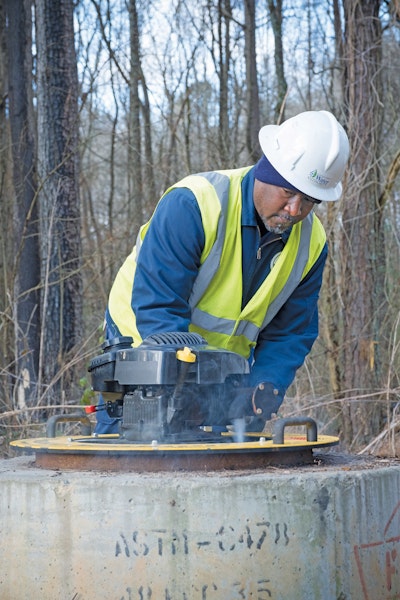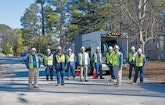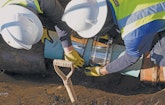
Clayton County Water Authority crew leader Tony Clay (left) and jet truck operator Juan Floyd use a Model 800 HPR jet truck from Sewer Equipment Company of America and a Southland Tool debris catcher to clean a sewer main.
(Photography by Kaylinn Gilstrap)
Interested in Infrastructure?
Get Infrastructure articles, news and videos right in your inbox! Sign up now.
Infrastructure + Get AlertsThe Clayton County Water Authority faces a big daily challenge. It serves one of Georgia’s most densely populated counties, but unfortunately sits atop a subcontinental divide, leaving it with limited natural water resources.
Yet during a severe drought in 2007-08, the five reservoirs the utility — based in Morrow, just south of Atlanta — relies on for drinking water never fell below 77% capacity. By comparison, the water level in nearby Lake Lanier, Atlanta’s primary source, hit record lows.
The utility sustained its drinking-water supply through an innovative system of constructed wetlands that filters treated effluent, discharged from two wastewater treatment facilities. The gravity-fed system then delivers around 17 million gallons of water per day to three of the reservoirs, where it’s stored for eventual reuse as drinking water.
“We like to say that it rains every day in Clayton County,” says Jeff Jones, the utility’s distribution and conveyance director and a 33-year employee.
Only a handful of metropolitan water and wastewater utilities nationwide use constructed wetlands as a final treatment stage for wastewater. And this outside-the-box approach to water sustainability is just one of many ways the utility embraces innovation and proactively tackles challenges, ranging from a comprehensive sewer line replacement program to utilizing technology that makes inspecting and cleaning lines more efficient and cost-effective.
Award-winning operations
The utility’s progressive agenda has earned it numerous state awards as well as a national reputation for innovation. For the last 11 years, it’s garnered gold and platinum collections system excellence awards from the Georgia Association of Water Professionals. The utility’s facilities also consistently earn recognition from GAWP. For example, the Northeast Water Reclamation Facility was named the 2020 wastewater plant of the year for advanced treatment in plants with a 6 to 9.9 mgd treatment capacity.
“We always try to be leaders in the industry — that’s always our objective,” Jones says. “We’re also big on innovation, which goes back to our board and management team. Our board has invested millions of dollars into upgrading our system.”
The utility provides water and sewer service to more than 290,000 people living in the roughly 143-square-mile county, which includes six incorporated
cities. It treats around 38 mgd, collected through 1,932 miles of wastewater lines. The system also includes 26,343 manholes and 42 lift stations.
The utility owns three wastewater treatment facilities. The biggest one, the W. B. Casey Water Resource Recovery Facility (named after the late William Casey, a 30-year board member), treats about 24 mgd; the aforementioned Northeast facility handles about 10 mgd; and the Shoal Creek Water Reclamation Facility treats roughly 4.4 mgd.
The five raw-water reservoirs have a total capacity of around 4 billion gallons and the utility can produce up to 42 million gallons of potable water per day. The utility operates roughly 1,500 miles of water mains.
Natural filtration
There are two constructed wetlands: The E.L Huie Jr. site — named after the late Edward Lynn Huie Jr., the general manager of the utility from 1960 to 1983 — in the center of the county and the Panhandle site on the southern end.
In simplest terms, the wetland sites use soil and a dense array of indigenous aquatic vegetation to filter treated effluent from the Casey and Shoal Creek treatment plants.
The larger of the two, the E.L Huie Jr. site, was completed in 2010 at a cost of $30 million. It covers 532 acres and includes 263 “cells” that can treat up to 17.4 mgd from the Casey treatment facility. It discharges treated effluent into the Shamrock and Blalock Reservoirs.
The Panhandle site was completed in 2003 at a cost of $4 million. It covers 55 acres and features 22 cells that can treat up to 4.4 mgd before it travels into the Shoal Creek Reservoir.
While enhancing the utility’s ability to sustain an adequate water supply, the constructed wetlands also decreased treatment costs. It cost $4.73 per gallon to build the wetlands facilities, compared to $10 per gallon for more conventional treatment methods, officials say.
Furthermore, wetlands treatment also allows for more efficient land use. With wetlands, the utility can treat a million gallons of effluent per day on 20 to 25 acres of land, while the prior method — an aeration-spray, land-application system — required 100 to 150 acres to treat the same amount.
The E.L. Huie Jr. site replaced an aging irrigation system built in the 1970s. Treated water from the Casey facility was discharged into four ponds. From there, a system that incorporated about 18,000 sprinklers and more than 250 miles of pipe distributed the water over 2,400 acres of timberland, Jones explains.
“It got to the point where it was very expensive to maintain and repair all those miles of pipes,” he says.
The only maintenance required by the wetlands is vegetation management. And since they use less land and require no electricity, there are additional savings as well.
Infrastructure improvements
Initiated in 2015, Project PipeFix is one of the utility’s largest capital improvement projects and reflects the utility’s proactive approach to upgrading facilities. When the first three phases are completed in 2022 at a cost of nearly $54 million, the utility will own more than 12 miles of new 60-inch-diameter outfall pipe, most of which carries wastewater to the Casey treatment facility.
“It’s the aorta of our system,” Jones says.
The project is being performed in seven phases that involve replacing mostly 24- and 48-inch-diameter clay, concrete and ductile-iron pipe, originally installed in the 1950s, with HOBAS Pipe USA fiberglass-reinforced pipe. The corrosion-resistant HOBAS pipe is guaranteed to last 100 years.
A combination of ratepayer revenue and low-interest loans from the Georgia Environmental Finance Authority are funding the project, says Suzanne Brown, the utility’s communications and community relations manager.
The utility also spends around $2 million annually to replace or rehabilitate problematic sections of smaller pipes identified by sewer evaluation surveys.
“Through this ongoing program, we’re investing in our community to ensure we provide quality services to our customers,” Brown says.
Embracing technology
The utility also uses technology to more efficiently perform routine sewer cleaning, aimed at minimizing sewer overflows.
Years ago, Jones says the utility tried to clean every foot of sewer line in the system, which could take about five years. But now it uses Cityworks asset-management software, developed by Azteca Systems, to detect sewer overflow hot spots.
“Now when we clean lines, we input information into a database and the software assigns a score that indicates how frequently pipes need to be cleaned,” Jones says. “Some pipes might need cleaning every year while others might require cleaning every five or six years or every six months.
“By assigning pipes a risk score, we’re not wasting time and resources cleaning things that already are clean.”
The new philosophy appears to be working, if the number of sanitary sewer overflows is any indication. Before the new approach was implemented, the utility averaged about 50 SSOs per year, not including those stemming from high rainfalls. But from May (the start of the utility’s fiscal year) through December 2020, there were only 17 non-weather-related SSOs.
Equipment investments
The utility has three two-man crews that clean sewer lines. To do that work, it owns two Vactor 4700 jetting trucks and one 800 Series jetter made by Sewer Equipment. It also owns a Vactor combination truck.
“We also have a troubleshooting crew in a smaller truck that tows a Model 545 trailer jetter made by Sewer Equipment,” Jones says. “We consider them as first responders that break through a stoppage really fast. Then we bring in the bigger equipment afterward.”
Starting in 2017, the utility also has relied on SmartCover technology to help minimize SSOs. Utilized on six manholes in hard-to-access areas with a history of overflows, the technology uses a satellite communications network to provide real-time monitoring of water levels in sections of sanitary sewers.
Utility staff can log in and view a graph of water levels on a laptop computer, tablet or cellphone. When water levels change, the system sends an alert via text or email.
The utility also spends about $2 million per year on sewer inspections. Three two-person teams use camera trucks outfitted by CUES, and Power Smoker smoke-testing units built by Hurco Technologies. The crews perform manhole inspections using Envirosight Quickview airHD pole cameras.
Smart investing
Looking ahead, Jones says continued development and population growth will present challenges, including the need for additional wastewater capacity at the Casey treatment plant.
“In the long term, we’re looking at enlarging the Casey plant,” he says. “It just makes more sense to invest money in upgrading the Casey plant because it’s in a central location.”
Moreover, the utility will remain focused on innovation and embracing technology whenever possible, he adds.
“We’ll keep on striving to be the best we can be.”








